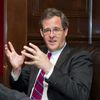Violence or civil disobedience?
That has been the perennial question facing the Civil Rights movement, which has evolved into the "Black Lives Matter" crusade.
From Thoreau to Gandhi to Martin Luther King, Jr., civil disobedience has been an extremely powerful weapon in spearheading needed social progress.
I recently watched The Great Debaters, an inspiring tale of a 1935 debate team from an all-black college in Texas that beats Harvard in a dramatic test of intellect, oratory and the ability to shape opinion through forceful language.
Spoiler alert: if you haven't seen this movie, skip the next paragraph.
At the end of the film, one of the African-American debaters opens and closes with this: "In Texas, they lynch Negroes... I have two choices: violence or civil disobedience. You should pray I choose the latter."
I was thinking of this scene recently as the vexing problem of racial injustice continues to plague our country, 80 years after the "Great Debaters" and almost eight years after our country elected its first African-American president.
Two incidents in the news involving African-American men who graduated from Harvard illustrates how far we still need to go to repair the ills our country has visited on African-Americans.
Carey Gabay, a top attorney in the Cuomo administration, was killed by a stray bullet while he was with friends on a late Saturday night, right before the West Indian Day Parade. Police think he was accidentally caught in the crossfire between two gangs. Gabay, a 43-year-old whose impressive background and commitment to public service was an inspirational immigrant tale, was yet another victim of our inadequate gun control laws.
Why in 2015 in New York City could rival gangs possibly be allowed to shoot at one another? Hasn't New York become the safest large city and haven't we finally solved the problem of random shootings that plagued the city in the 1970s and 80s?
Apparently not.
What to do? We need to empower the NYPD to aggressively get guns off our streets. But doesn't that necessitate using the controversial tactic of "Stop, Question and Frisk" more often? Probably. And there lies the rub.
In the past few years, New York's aggressive policing tactics have come under heavy scrutiny, and as a result the frisking of many people has dropped dramatically. Would aggressive policing on Bedford Boulevard the night Carey Gabay was shot have saved his life? Probably.
Fast forward one week and we see the perils of aggressive policing in another incident involving an African-American Harvard graduate -- this time in broad daylight in midtown Manhattan. James Blake, who was once a highly ranked tennis player, was thrown to the ground by a plainclothes NYPD officer who mistakenly identified Blake as a suspect in an identity theft ring.
The video released to the public graphically illustrates the use of excessive force. Blake was pinned, handcuffed and held for more than 10 minutes before another police officer pointed out that he was actually a famous retired tennis player, not a petty thug. Fortunately, Blake did not suffer the same fate as Eric Garner, the asthmatic man whose crime of selling loose cigarettes on a Staten Island street tragically ended in his death after police used excessive force to subdue him.
What are the lessons in all this? First, that strong and measured policing is absolutely necessary to continue to make New York a safe place. Second, the NYPD must be allowed to aggressively attack areas that have street gangs to ensure they do not have gunfights that can lead to tragedies like Gabay's. Third, excessive force must be curtailed; the NYPD should have a "zero tolerance" policy here. The officer who tackled Blake had two pending complaints against him for excessive force. He should not have been on the street in that identity theft sting. What if Blake had resisted, not knowing the plainclothes officer was a cop, and had been shot in this botched arrest?
On a more macro level, we need to realize that even African-American men like Blake and Gabay, both graduates of the most prestigious university in the land, are not immune to random violence and improper policing.
After the incident with the police, Blake was gracious in taking calls of apology from the mayor and the police commissioner. He did, however, rightly express his belief that the police officer who threw him to the ground should no longer be on the street.
How should we as a society react to these not infrequent incidences of excessive force being used against minorities? As the "great debater" said in 1935: We could choose violence or civil disobedience.
Let's pray that those who are victims of injustice, like James Blake, continue to choose the latter.
Tom Allon, the president of City & State, NY, is the former Liberal Party-backed candidate for mayor. Questions or comments: tallon@cityandstateny.com
